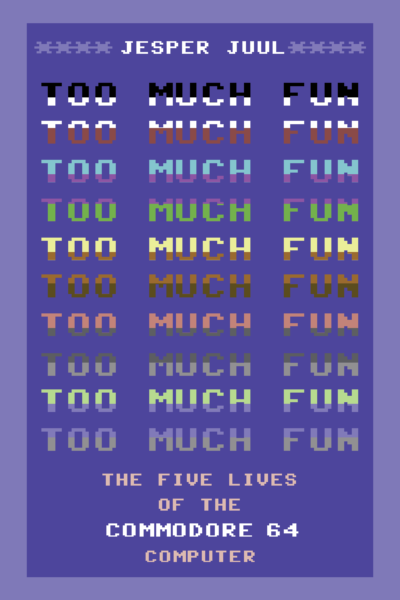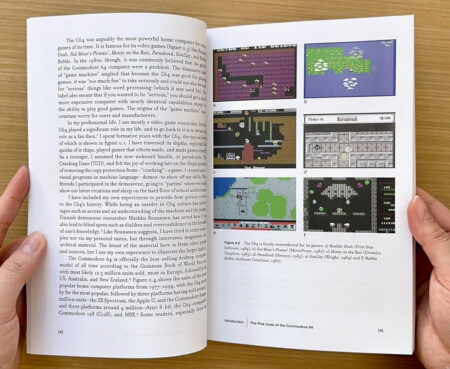
It is real: I am thrilled to announce that my new book, Too Much Fun: The Five Lives of the Commodore 64 Computer is out today on MIT Press.
Too Much Fun is a book about two central mysteries. First, why is the best-selling Commodore 64 computer absent in many computer and video game histories, and what is the influence of its games from SimCity to IK+ to Paradroid? Second, why did this early computer, destined for a shelf life of just a few years, live so long, and end up being produced from 1982-1994?
Writing Too Much Fun has been an incredible journey with twists and turns. I’ve interviewed Commodore engineers, played the games, read the magazines, learned to program the machine again, and connected with new and old friends on the demoscene. All this just as the Commodore 64 is experiencing a renaissance with new games, operating systems, hardware, and events!
Full of interviews, surprising anecdotes, and color illustrations, Too Much Fun tells an epic story of the C64. Too Much Fun is for anyone interested in computer or game history, in how devices can be made to live longer, and for anyone who had, or didn’t have, a Commodore 64. I hope you’ll enjoy it.
How to get the book: Too Much Fun is available as ebook, from your local independent bookstore, MIT Press, or your favorite online retailer.
The book’s support site has extra material, ads, videos, source code, and emulators. https://www.jesperjuul.net/c64/
*
Official description: The surprising history of the Commodore 64, the best-selling home computer of the 1980s—the machine that taught the world that computing should be fun.
The Commodore 64 (C64) is officially the best-selling desktop computer model of all time, according to The Guinness Book of World Records. It was also, from 1985 to 1993, the platform for which most video games were made. But while it sold at least twice as many units as other home computers of its time, like the Apple II, ZX Spectrum, or Commodore Amiga, it is strangely forgotten in many computer histories. In Too Much Fun, Jesper Juul argues that the C64 was so popular because it was so versatile, a machine developers and users would reinvent again and again over the course of 40 years.
First it was a serious computer, next a game computer, then a computer for technical brilliance (graphical demos using the machine in seemingly impossible ways), then a struggling competitor, and finally a retro device whose limitations are now charming. The C64, Juul shows, has been ignored by history because it was too much fun. Richly illustrated in full color, this book is the first in-depth examination of the C64’s design and history, and the first to integrate US and European histories. With interviews of Commodore engineers and with its insightful look at C64 games, music, and software, from Summer Games to International Karate to Simons’ BASIC, Too Much Fun will appeal to those who used a Commodore 64, those interested in the history of computing and video games and computational literacy, or just those who wish their technological devices would last longer.
Endorsements
“Jesper Juul has provided a long-needed addition to the Platform Studies series. It’s a wonderful book, as readable as it is informative.”
Jimmy Maher, author of The Future was Here: The Commodore Amiga
“A beautiful, sincere, and rich account of everything that makes this influential computer so special to me: that unique punk stew of technology, creativity, culture, people, and zeitgeist.”
Gary Penn, editor of Zzap!64; inaugural Games Media Legend; author of Sensible Software 1986–1999; Creative Director at DMA Design
“In this standout contribution to the Platform Studies series, Juul illuminates the overlooked career of the Commodore 64 home computer by integrating the perspectives of hardware designers, marketeers, game programmers, demo creators, and retrocomputing enthusiasts.”
Thomas Haigh, lead author of ENIAC in Action and A New History of Modern Computing
“As someone who has a wealth of knowledge on this subject, this book is ‘highly recommended reading,’ so do not hesitate—just buy this book and rejoice.”
David John Pleasance, musician, former Managing Director, Commodore UK, author of Commodore: The Inside Story
Scheduled book talks

 I am happy to welcome Matthew Farber and Tracy Fullerton’s wonderful new book The Well-Read Game: On Playing Thoughtfully to the Playful Thinking series!
I am happy to welcome Matthew Farber and Tracy Fullerton’s wonderful new book The Well-Read Game: On Playing Thoughtfully to the Playful Thinking series!










